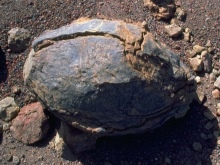All about volcanic tuff

Our planet is a complex geological organism with a red-hot core, a layer of boiling magma under the lithospheric plates and a raging internal energy that, throughout the entire history of the Earth, erupted outward by volcanic eruptions. The result was the formation of many specific rocks, one of which is volcanic tuff.

What it is?
Tuf - a general definition, derived from the Latin word tufus, after all, since the time of Ancient Rome, Italy has been mining this stone (mainly of the calcareous type: it was he who was used in the construction of the Colosseum). The name unites three varieties, which differ in terms of formation and mineral composition:
- volcanic - compacted detrital volcanic material;
- calcareous (travertine) - sedimentary rock, the composition is based on calcium carbonate;
- siliceous (geyserite) - geothermal origin, formed by the precipitation of silicon compounds from the waters of hot springs (geysers).



Origin
The volcanic type is formed by cementation of pyroclastic (literal translation from Greek - broken by fire) rocks. Debris and fractions of crushed stone and effusive rocks of a given area are thrown by the explosive force of gases into the air, and falling to the surface are mixed in a hot lava flow with surface dust, clay, sand and ash, sticking together into a solid stony mass.


Tuff deposits are located in natural relief depressions near long-extinct (and sometimes active) volcanoes in Turkey, Italy, America, Azerbaijan, Georgia, and Russian Kabardino-Balkaria. The tuff from Armenia is famous all over the world, it is not for nothing that its beautiful capital is called the "pink city".
Temples, government buildings, residential buildings in Yerevan are faced with slabs of all sorts of shades from red-brown to black, but pink and lilac-violet tones of artik tuff predominate.

The Artik field is located at the foot of the Aragats stratovolcano mountain (according to legend, the sister of the legendary Ararat peak). In the 20th century, it was considered the world's largest industrial tuff mining center. In Armenia, there are 5 varieties of this breed, experts consider the Artic pink stone to be an exemplary material for finishing cladding and construction.

Structure and texture
The structure of tuff beds is porous-clastic. The stone is distinguished by the following textural features:
- the presence of fragments of rubble, minerals, frozen lava;
- structural heterogeneity;
- unsorted components;
- no lamination.

The shape of the fragments in the composition of the stone can be:
- rounded - volcanic bombs;
- acute-angled - crushed stone;
- curly.



Tuff is classified by the size of debris-inclusions into 7 types:
- blocky agglomerate with fragments larger than 200 mm;
- agglomerate (50-200 mm);
- lapillian (10-50 mm);
- small-capillary (2-10 mm);
- medium clastic, gravel (0.1-2 mm);
- fine-grained (0.01-0.1 mm);
- fine-grained, ash (less than 0.01 mm).


Properties
The unique physicochemical composition of volcanic tuff determines its advantages over many popular building materials. It is easy to handle, it is simply cut into pieces and layers.
Basic properties:
- porosity;
- low specific gravity;
- high compressive strength (higher than that of bricks);
- hardness;
- good sound insulation;
- low thermal conductivity;
- insignificant hygroscopicity;
- frost resistance;
- fire resistance;
- durability.
Tuff is appreciated for its excellent decorative qualities. It has a wide color palette, although the color is heterogeneous, with splashes. The color depends on the composition of the effusive rocks of a particular area.

Species overview
Almost 90% of volcanic tuffs consist of products - emissions from explosive eruptions. Often there is a movement of clastic material with mud flows and saturation of the rock with secondary minerals. If other impurities prevail, then tuffs are divided according to their mineral composition into:
- andesite;
- liparite;
- basalt;
- trachytic.
Tuffs are sintered and cemented; strength characteristics depend on the method of formation. Sintered rocks are stronger than those bonded with natural cements.

By density, they are divided into:
- tracks - tightly compressed;
- pozzolans are loose.
Application
Man uses this durable and beautiful material in various fields: construction, production of crushed stone and mixtures, decorative art, aquarium keeping.
The cut panels are used for interior (steps of stairs, door, window, fireplace portals) and exterior cladding of buildings. They give the buildings a monumentality and unique style. In the form of blocks, they are used to erect walls of low-rise buildings, in particular, in places with high humidity or in harsh climatic conditions with temperature extremes (for example, monasteries and temples in the mountains). The material is excellently combined with other polished stone species, wood, glass, metal surfaces, and bright architectural details are created from it.

Tuff contributes to savings: the heat transfer of the room is reduced by 30-40%. Cement is enriched with crushed tuff additives, giving the composition additional resistance to seawater when it is necessary to erect underwater structures.
Large tuff stones can often be seen in the design of aquariums, imitating the natural environment of the seabed. Their high decorative value and low weight make them an attractive design element for the keen aquarist.

Landscape architects often use the material in the design of gardens and parks.

Sculptors and stone carvers also appreciate this volcanic rock, creating true works of art from it.

For information on how you can decorate a summer cottage with tuff, see the next video.






The comment was sent successfully.